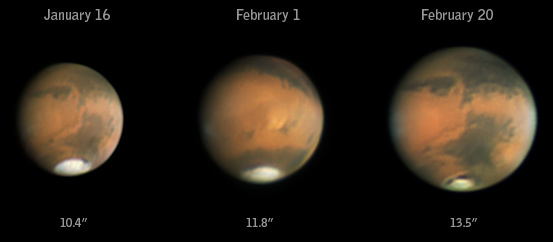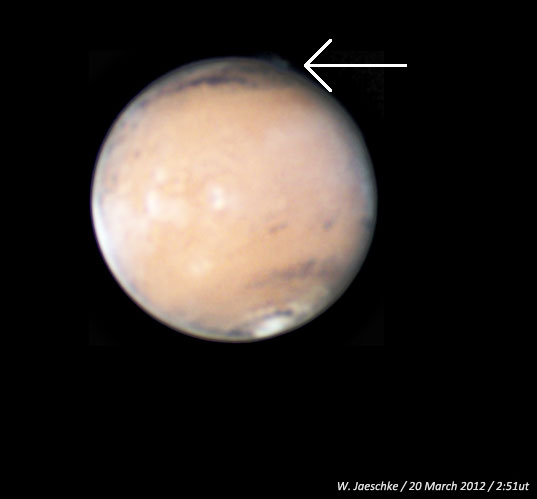Go look at Mars!

These past few days the Moon, Venus, and Jupiter have been showboating in the west right after sunset. They're so bright they're mesmerizing, but you're missing something if you literally don't turn around. Sitting in the belly of Leo the Lion is the next planet out from the Sun: Mars.
[Click to enaresenate, and also see a way cool animation of Mars rotating.]
That's the view seen by frequent BABlog contributor Emil Kraaikamp, who takes pretty amazing astrophotos. But even by eye, Mars is dazzling. It orbits the Sun farther out than Earth does, so we overtake it every couple of years or so. When that happens Mars and Earth are as close together as they can be -- think of it like two cars on a racetrack, so when one passes the other they're in close proximity, and every other time a lot of distance separates them. This just happened a few weeks ago, so Mars looks amazing right now.
In fact, because Mars is close, it's been the target of many amateur astronomers recently. Wayne Jaeschke was observing it on March 20th from West Chester, Pennsylvania and noticed something odd: a blob or bulge on the edge of the planet!
[Click to see the original; I brightened the image to make the anomaly more obvious. Go to the CloudyNights forum to see lots more pictures and discussion!]
This is almost certainly a high-altitude cloud of some sort; Mars does have an atmosphere and weather. Clouds over the Red Planet are common enough, and can be spotted through small telescopes, though one at this altitude is unusual. They've been seen before like this, so it's not completely unheard of, but that doesn't make it any less interesting! Wayne also put up an amazing animation where you can see the cloud on the upper right edge of the planet, and you really get a sense of how high up it is. Alan Boyle at Cosmic Log has more.
But you don't need a telescope to go out and look! I was out the other night, in fact, and saw the bright star Arcturus rising in the east. Mars and Arcturus are both about the same brightness right now, and also both very close to the same color -- Arcturus is a bright orange giant star, much like the Sun will be in a few billion years. If you live in the northern hemisphere, go out around 11:00 p.m. and face northeast. You'll see the Big Dipper easily enough; extend the arc of the handle down and to the right and you'll see Arcturus like a charcoal ember glowing in the sky (as we astronomers like to tell people, "Follow the arc to Arcturus").
But if you do have a telescope, now's the time to look. As our planet pulls away from Mars, it'll look ever smaller through the eyepiece. Not that Mars is all that big; it's 1/3 the Earth's diameter and still 100 million km away! But you never know what you might see.
Image credits: Emil Kraaikamp; Wayne Jaeschke; both used with permission.
Related Posts:
- The blue clouds of the Red Planet
- Rosetta's stunning Mars
- Between the Devil and the deep Red Planet
- Frosty blue dunes on Mars






























